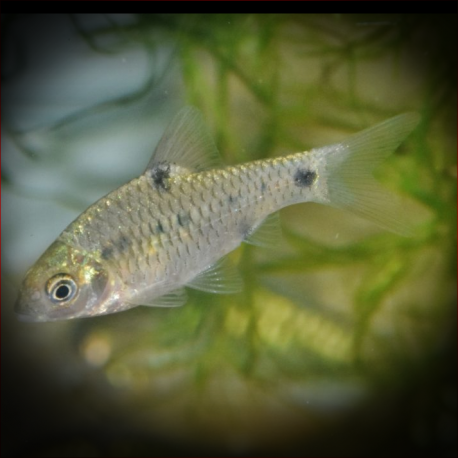Barbodes Binotatus
Cypriniformes Print
More info
Datasheet
| Minimum Tank Size | 240 litres / 63.40 US gallons |
| Maximum Size | 20.0cm / 7.87inches |
| Temperature | 18°C / 64.40°F - 30°C / 86.00°F |
| Hardness | 2.02dgH / 36ppm - 12.05dgH / 215ppm |
| pH | 6.0-7.5 |
General Description
The Barbodes Binotatus, commonly known as the Spotted Barb, is a species belonging to the order Cypriniformes. The adult color pattern typically features dark spots at the base of the dorsal-fin origin and on the caudal peduncle. These spots may vary in size and darkness among individuals, with juveniles showcasing additional markings on their fins. This species can be distinguished from similar-looking species by specific markings on their flanks, such as dark wedge-shaped patterns.
Aquarium Setup
Setting up an aquarium for Barbodes Binotatus involves creating an environment resembling a flowing stream or river. It is recommended to use variably-sized water-worn rocks, sand, fine gravel, and driftwood to simulate a natural habitat. While most aquatic plants struggle in such conditions, hardy varieties like Microsorum, Bolbitis, or Anubias spp. can thrive when attached to the décor. It is crucial to maintain high dissolved oxygen levels, moderate water movement, and conduct weekly water changes of 30-50% tank volume for optimal conditions.
Behaviour
Barbodes Binotatus is a gregarious species that thrives in groups of six or more individuals. Keeping them in decent numbers helps reduce skittish behavior and promotes a more natural display. They exhibit hierarchical behavior within groups, which minimizes aggression as they establish their positions. When selecting compatible fish communities, thorough research is recommended to ensure a peaceful tank environment.
Feeding and Diet
As foraging omnivores, Barbodes Binotatus typically consume worms, insects, crustaceans, and plant material in their natural habitat. In an aquarium, they are easily fed with a balanced diet consisting of small live and frozen foods like bloodworms, Daphnia, and Artemia, alongside high-quality dried flakes and granules. Providing regular meals will maintain their optimal condition and vibrant colors.
Reproduction & Dimorphism
During reproduction, Barbodes Binotatus behaves as an egg-scattering free spawner without parental care. To maximize breeding success, a controlled approach is recommended, involving setting up a separate breeding tank with specific conditions, including slightly acidic to neutral pH and dim lighting. Adult males develop more intense coloration and noticeable tubercles during spawning, while females tend to grow larger and have a heavier body.
Habitat and Distribution
The Spotted Barb is native to various regions, including Myanmar, Thailand, Peninsular Malaysia, Singapore, and several islands in the Greater Sunda region. It is commonly found in river drainages like the Mekong, Ayeyarwaddy/Irrawaddy, and Chao Phraya. Inhabiting diverse biotopes, it can thrive in environments ranging from fast-flowing hill streams to irrigation canals and floodplain ponds. The species prefer substrates of mud, sand, rocks, or boulders, often alongside submerged woody structures and macrophytes like Cryptocoryne and Barclaya spp.

